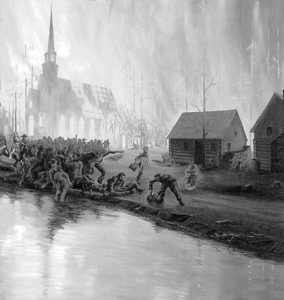
An artist’s rendering of the Peshtigo Fire, October 8, 1871. As wind-fed fire raged through town, people fled to the river. (Photo credit: The Capital Times Archives)
The Peshtigo Fire was the largest wildfire in U.S. history and occurred on Oct. 8, 1871.
The fire swept through the eastern and western shores of Green Bay, burning more than 1.28 million acres.
The town of Peshtigo — where an estimated 1,200 people died in the blaze — was hit particularly hard, resulting in the blaze being called the Peshtigo Fire.
The fire also destroyed Williamsonville, one of the shingle mill sites of Door County. Tornado Memorial Park is near this former town and commemorates victims who lost their lives fighting a “tornado of fire.”
A fire tornado is a swirl of fire that extends upward from a ground fire.
These vortices can occur over a range of fire sizes but the largest are associated with wildfires. Fire tornadoes are usually 30-200 feet tall and about 10 feet wide. Generally, they last for only a few minutes.
Fires require fuel to burn, air to supply oxygen and a heat source to get the fuel to its ignition temperature. The logging and land clearing practices of the time period, along with the sawmills of the area, provided debris that served as fuel for the Peshtigo Fire.
There were many small fires in the summer of 1871. While instrument weather stations were not available, diaries and other records indicated below-average rainfall over most of the area from June through September 1871. This was likely an important factor in the devastating October fire.
Once a fire starts, weather can influence how it will spread and if it will grow. The important weather factors are temperature, wind and humidity.
Warmer temperatures allow fuels to ignite quickly and low humidity keeps fuel dry and easy to burn. Wind brings oxygen to a fire and can also help it spread. A large fire can generate a wind pattern of its own that can help spread the fire, too.
The fame of the Peshtigo Fire is limited by the better-known Great Chicago Fire, which occurred on the same day, burning up 3.3 square miles of land and killing 300.

